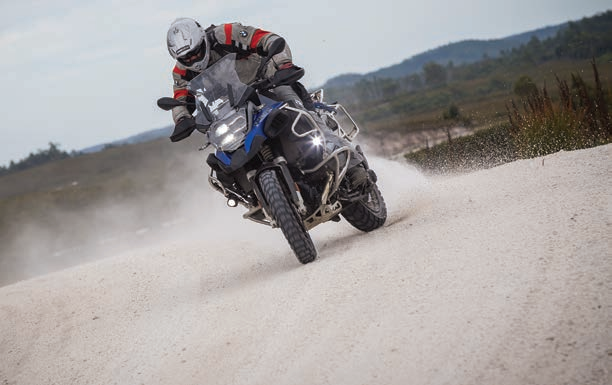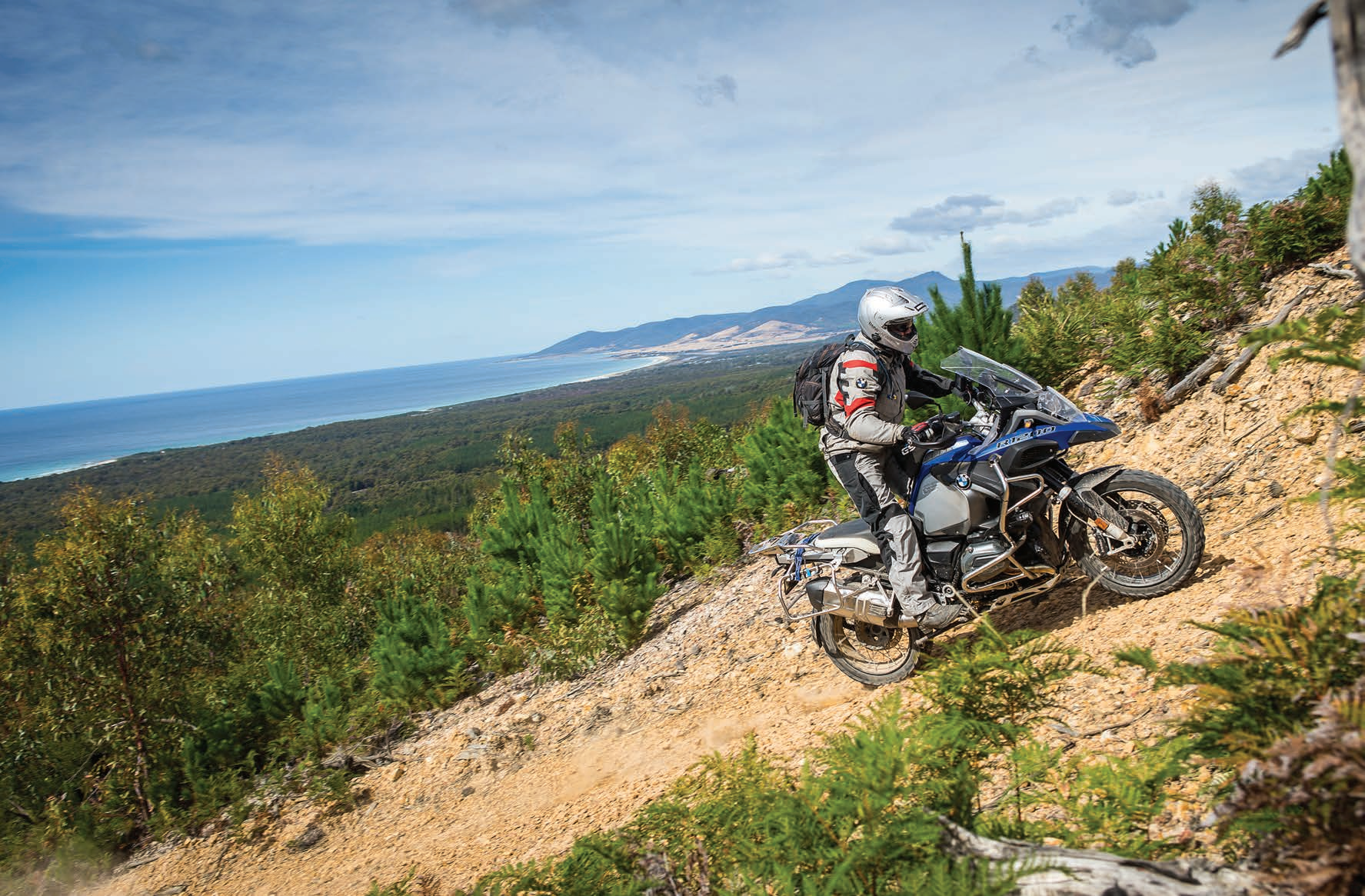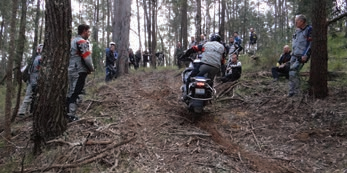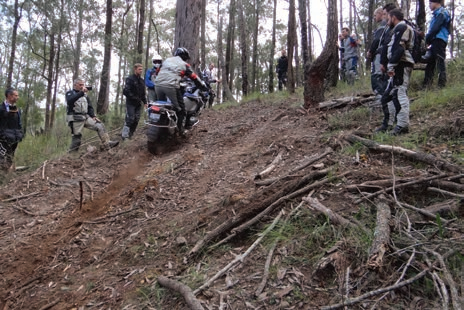- Bianca Pollard
- It’s What We Do
- The Congregation
- Great Rides Volume 3:North-west NSW
- Industry Players:Matt Phillpott
- Armour
- Hard-pannier Hard men
- Shop Bike
- Cambodia:Temple Central
- Trophy Hunter
- Chris Birch
- Cannonball Lima Cali
- Bright to The Gulf
- Picture This
- How To Ride with Miles Davis
- Adventure Travel Film Festival
- Miles of Smiles with Karen Ramsay
- Checkout
- Fit Out
When the going gets tough
Maintaining control when conditions get tricky

Sometimes you see situations where conditions are challenging: slippery, rutted, sandy, rocky, or steep.
It’s when you really see who has bike control.
Some riders simply have no chance. Some maybe make it through with aggression and speed while others float through in total control and make it look easy without excess revs, speed or fuss.
How do they do it? Luck? Tyres?
Tyre pressure? Suspension?
Probably not.
Usually it’s the fact that they can read the situation, understand what’s required, and execute well without compensating with excess revs or speed.
Like most sports or activities, having a solid grasp of the basics is always going to help when it comes to more challenging situations.
It doesn’t matter if it’s snow skiing or golf, windsurfing or riding motorcycles. Some riders skip gaining a good feel for the basics and get to an intermediate level on many years of ‘survival’ experience and a solid dose of confidence. This can definitely work, but when push comes to shove, sometimes it doesn’t.
 Miles Davis
Miles Davis
Beginners
Some riders are in an ‘ideal’ situation. Maybe they grew up riding on a farm, or ride with experienced friends or family to guide them. Others may have started as young BMX, trials or motocross riders in a club environment with good skills-development programs. Some might have a surfing background (people who surf well can pretty much do anything well by about the second or third time they try it, I know. Bastards!)
But many riders who’ve taken up adventure riding may not have these ideal backgrounds. They may also be starting out later in life, without the advantages of youth on their side. I see it all the time and I totally understand how daunting it can be.
My point is, if you’re getting into adventure riding without a good grasp of the basic skills of off-road riding, you do have the option to invest in developing your skills.
It’s as simple as that. Some people understand this from previous experiences in work or play when they got ‘skilled up’ and it made all the difference. Others somehow see through different eyes. They’re the ones that filter out that idea and replace it with the thought that they simply wouldn’t benefit from that sort of thing. They think: ‘It’s for beginners and I’m no beginner’.

Hang ups
Back to my story
If you see a rider making things look too easy, there’s usually a bit of a story behind it. And almost always that story involved, at some stage, a lot of practice of good basic skills. Maybe hundreds of hours. Combine the practice with many hours of riding and there you have it – a rider who instinctively understands what they’re doing and how to get the best results. And the best part of this whole thing is, you never stop learning! Well, I say ‘never’, but at some point you probably have to hang up your helmet. But I’ve met lots of riders who are in their 70s and 80s and still enjoy riding their bikes and do it very well.
So if you’re reading this, you probably know how to ride a bike, and the majority would probably like to ride their bikes better.
Here are some things to think about that might help. They’re not a substitute for basic training if the basics aren’t completely sorted yet, but it might give you an insight into riding better, easier, safer and probably faster.
 Keep your bike balanced. Be relaxed and agile and breathe.
Keep your bike balanced. Be relaxed and agile and breathe.
Balance point
A rider’s job is to keep their bike balanced and give appropriate control inputs.
Nothing more, nothing less.
Bikes only have two wheels and can become unbalanced and fall over very easily. Big adventure bikes in tricky conditions can be a handful, and keeping the big girl balanced sometimes isn’t as easy as some would like. We covered riding position and stance in issue #01, and that’s the first step: the rider being an active element of the balanced bike.
But there’s much more.
Think of the bike as a seesaw, and you’re in the middle, gently shifting your weight front-to-back and side-to-side in order to keep the bike in that happy balanced place.
But your controls play a big part too. One of the most common things I see is riders who are total throttle jockeys. They work the throttle hard and often. Have a think about it. Every time you add or remove a large amount of throttle you’re potentially throwing balance out the window as the bike drives forward or dives under deceleration. Smaller, precise inputs can be much better, allowing the bike to glide over bumps or slippery sections while staying balanced and in control. These precise inputs are not so obvious to an observer, but they’re very effective, especially when well-timed with subtle balance inputs.
This, my friends, is how lots of riders seem to make tricky situations look so easy.

Control freak
Everyone has heard of throttle control.
It’s very important, especially when grip is low. Then you have brake feel and clutch control also, so when everything is combined at the right level things become much smoother, easier and less fatiguing.
Human instinct doesn’t always help.
It’s very common for riders to want to grab a fistful of throttle, and it definitely takes practice to be more measured and precise. It’s also very common for a rider to want to chop the throttle when they get anxious. This can unbalance the bike just as easily, especially in slippery or sandy conditions. A constant throttle through these tricky situations can be such a benefit, doing nothing but holding the throttle steady with very gentle power going to the back wheel.
During some of my outback rides I’ve played with cruise control and have been amazed at how stable a bike can be, it’s a real eye opener (WARNING: Don’t try this at home). I’m not saying you should set cruise control off-road, but you can be the cruise control, and simply hold the throttle steady.
Situation A: riding along at 80kph-90kph on a flat, straight road where the gravel has built up a soft hump or pillow in between.
two clean tyre tracks. Simply moving from one tyre rut to the other can be quite unsettling for many riders. But sometimes you need to cross these sections, so you might as well practice it. I’d say this is one of the first things to do to get comfortable with riding in sand.
Try this: stand up in a good ‘attack’ position, central on the bike, and sweep across the soft gravel without adjusting your throttle (as if in cruise control). The bike will shimmy slightly as it crosses the loose stuff and feel rock-solid when you hit the other tyre track. Keep doing it. Sometimes it might help to add a tiny bit of throttle, especially if the shimmy gets more aggressive.
If you did the same thing but added a lot of throttle or chopped the throttle in the loose stuff, the bike would get unbalanced very quickly.
Once you feel more relaxed you can actually stay in the loose stuff and ride along between the two tracks. The bike will shimmy, but that’s all it will do.
Suddenly this light should go off in your head, flashing, ‘A constant throttle keeps your bike balanced and happy!’
As you continue to feel more relaxed, try adding and reducing throttle very gently and you’ll see how very small inputs can affect the bike.
This is big. This is throttle control and it can help you in so many situations.
You can also practice throttle control by slow riding and doing full-lock slow circles and other discipline work – see issue #02 when we covered throttle and clutch control and exercises.

Riding sand
Like I said, this is the first step to getting your head around riding sand. You don’t just lean back and hold it flat like a lot of people will tell you.
On the recent GS Safari Enduro we rode lots of sand, starting off quite mellow and building up to being very full-on. At one of our rider briefings before the big Hattah Desert day, I talked to a group about how to get their heads around deep sand. In essence, the main things I said were:
• Keep your bike balanced, be relaxed and agile
• Be positive and precise on the throttle, but use only what’s required (be the cruise control)
• Don’t hesitate on adding throttle. You have a small window of time to add precise throttle before the bike starts getting very unbalanced
• Don’t over commit and go too fast. This can end badly as you’ll have to slow down eventually At the end of this huge day a lot of the riders said this approach worked and gave them the confidence they’d never had in the sand. For sure, at times sand requires a lot of throttle, but not always.
At the end of the trip, some riders also commented, “I really wanted to learn and experience sand, and I did, and now I know I prefer my sand on the beach, not on a bike”. It’s a good point, because riding a big bike in sand is pretty full-on, and it’s not for everyone.
The key here is to find that out before you end up going upside-down in a big way


















Comments